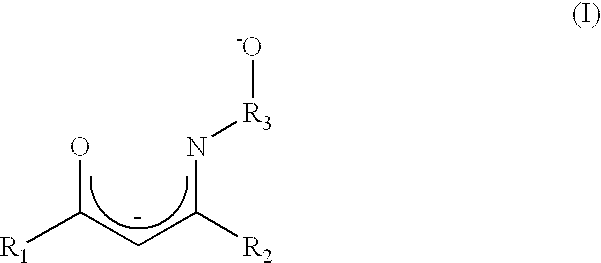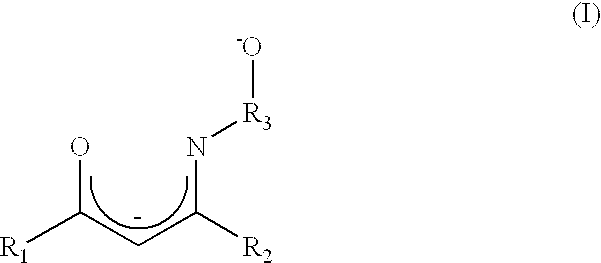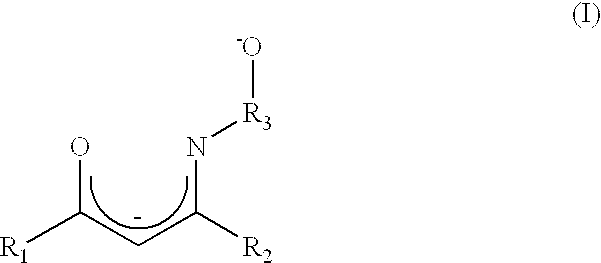Atomic layer deposition method using a novel group IV metal precursor
- Summary
- Abstract
- Description
- Claims
- Application Information
AI Technical Summary
Problems solved by technology
Method used
Image
Examples
example 2
Preparation of Ti(CH.sub.3C(O)CHC(NCH.sub.2CHCH.sub.3O)CH.sub.3).sub.2, Ti(2 meip).sub.2
[0036] 11.06 g (70.36 mmol) of the tridentate ligand CH.sub.3C(O)CHC(CH.sub.3) (HNCH.sub.2CH(CH.sub.3)OH) prepared in Example 1 was dissolved in 20 ml of methylene dichloride. To this solution, a solution of 10.00 g (35.18 mmol) of titanium(iso-propoxide)4, Ti(O-iPr).sub.4, in 25 ml of methylene dichloride was added through a cannula at room temperature with stirring. The mixed yellowish solution was stirred for 4 hours or more, and then the solvent was removed therefrom under a reduced pressure. The remaining material was recrystallized from a mixed solution of methylene dichloride and n-hexane at -20.degree. C. to give 12.18 g (96% yield) of Ti(CH.sub.3C(O)CHC(NCH.s-ub.2CHCH.sub.3O)CH.sub.3).sub.2 as a pure yellow solid.
example 3
Volatility of Ti(2 meip).sub.2
[0037] The precursor Ti(2 meip).sub.2 prepared in Example 2 was analyzed by TG-DSC under nitrogen atmosphere and oxygen atmosphere. The results are shown in FIGS. 1a and 1b. As seen from FIG. 1a, the precursor Ti(2 meip).sub.2 was rapidly vaporized in a temperature range of 250 to 300.degree. C. and leaved few residues less than 0.5% after vaporized. Thus, Ti(2 meip).sub.2 was proved to have excellent volatility. Further, it could be found that the precursor Ti(2 meip).sub.2 was not decomposed during the vaporization, because no exothermal peaks were observed before and after the vaporization. While the precursor Ti(2 meip).sub.2 has a relatively low vaporization rate compared to the prior titanium precursors as shown in FIG. 2, it exhibits more high volatility than the conventional alkali earth metal precursors. Thus, the precursor Ti(2 meip).sub.2 is useful particularly in formation of a multi-component thin film with the alkali earth metal precursors...
example 4
Chemical and Thermal Stabilities of Ti(2 meip).sub.2 Under a Carrier Gas Atmosphere
[0038] IR spectra of the precursor Ti(2 meip).sub.2 prepared in Example 2 were obtained according to a temperature rise and plotted in FIGS. 3a and 3b. As seen in FIG. 3a, position of the respective absorption peaks did not change along with the temperature rise, whereas intensity of the peaks declined due to reduction of the precursor amount by vaporization. This indicates that the precursor Ti(2 meip).sub.2 h as excellent thermal and chemical stabilities. Moreover, TG-MASS spectrum of Ti(2 meiP).sub.2 is shown in FIG. 4, from which it could be also found that Ti(2 meip).sub.2 is thermally stable, because a peak at 358 m / z corresponding to its molecular weight constantly appeared even up to a high temperature. Further, gases evolved from the precursor Ti(2 meip).sub.2 at 320.degree. C. and 530.degree. C., respectively, were subjected to mass spectrometry, and the results are shown in FIGS. 3a and 5b....
PUM
| Property | Measurement | Unit |
|---|---|---|
| Chemical stability | aaaaa | aaaaa |
| Thermal properties | aaaaa | aaaaa |
Abstract
Description
Claims
Application Information
 Login to View More
Login to View More - R&D
- Intellectual Property
- Life Sciences
- Materials
- Tech Scout
- Unparalleled Data Quality
- Higher Quality Content
- 60% Fewer Hallucinations
Browse by: Latest US Patents, China's latest patents, Technical Efficacy Thesaurus, Application Domain, Technology Topic, Popular Technical Reports.
© 2025 PatSnap. All rights reserved.Legal|Privacy policy|Modern Slavery Act Transparency Statement|Sitemap|About US| Contact US: help@patsnap.com



